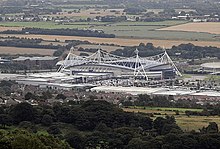Horwich
Horwich (/ˈhɒrɪtʃ/ HORR-itch) is a town and civil parish in the Metropolitan Borough of Bolton, Greater Manchester, England,[1][2] within the historic county boundaries of Lancashire.
The textile industry became a major employer and after 1884 the construction of the railway works caused the population of the town to increase dramatically.
The name Horwich derives from the Old English har and wice, meaning the place at the grey wych-elm and in 1221 was recorded as Horewic.
[7][8] Ancient records are of Horwich Forest being overrun with wolves in the time of Ecgfrid, ruler of Northumbria until 685, 'Smithills walled round to keep them at bay'.
[8] By the Middle Ages Horwich was a hunting chase, after the Norman Conquest held by Albert de Gresle between 1086 and 1100.
[10] In 1277 Robert Gresle, Baron of Manchester prosecuted Martin de Rumworth for carrying off deer in Horwich Chase[11] which was described in 1322 as being within "a circuit of sixteen leagues with a yearly value in pannage, aeries of eagles, herons and goshawks, in honey, millstones, and iron mines, in charcoal-burning, and the like issues, 60 shillings; of which the vesture in oaks, elms and wholly covered with such, 160 marks.
[13][14] The decline of Horwich forest is connected to the dissolution when Henry VIII seized all the church lands and then sold them.
By the 16th century, subsequent to the reformation land ownership had shifted from Church to the crown and was then sold to new owners, who transformed the town into an agricultural economy, and forests were cleared.
Many of the farms from the period still existed until the housing boom of the 19th and 20th centuries, like many Lancashire towns the cotton industry was prominent as at least a secondary occupation in many households, weaving became a widespread occupation, and industries like bleaching, dying and paper making grew from the use of water power with the towns preindustrial plentiful access to flowing water.
[7] A plague pit is noted on the map, with victims of a 1623 outbreak, interred in a mass grave under what is now Lever Park Avenue.
Race meetings were held between 1837 and 1847 at the 'Old Lords estate', an area next to the Rivington border, named after 11th Baron Willoughby.
Richard Pilkington, a leading non-conformist and owner of Horwich Manor, and his family feature in the town's history from the post Protectorate to the industrial revolution being benefactors and founders of a number of places of worship.
[20] In the 1770s brothers, John and Joseph Ridgway, land agents to the Blundells, moved their bleach works from Bolton to Wallsuches.
[25] In 1881 the population of 3,761 lived in 900 houses and had remained stable for fifty years, the arrival of the railway works and other industries including W.T.
Large areas of former farmland was built on with the creation of vast numbers of brick terraced house streets of Victorian and Edwardian types of two-up two-down for the working class who had arrived from across Britain and Ireland, still used in the 21st century.
During World War II the factory manufactured variable pitch propellers for Spitfires, making it a target for German bombers, who in July 1942 attempted to raid the factory by employing some of Germany's best pilots and crews in two Junkers JU 88 bombers in a mission using the Rivington reservoirs as landmarks to navigate at low level flying over the water then rooftops of Lever Park to find its target.
[32] Horwich works was very active in armament production in the first and second world wars, in recognition George VI and his wife Queen Elizabeth visited the town in 1940.
The long brick built workshops had full-height arched windows and were separated by tram and rail tracks.
The war led to women being employed in manufacturing at the site, but this did not continue in post-war years with occupational inequality persisting.
Horwich Works continued to build and repair locomotives for the LMS until the company was nationalised in 1948 by the Transport Act 1947, becoming British Railways.
Protest marches and spirited trade union resistance failed to alter the decision and at 1 pm on Friday, 23 December 1983 Horwich Works closed after 97 years.
The town went through a period of high unemployment afterward, [21][22][35][36] The freehold of the railway works site was transferred from British Rail to Bolton Council in the mid-1990s.
Horwich was within the county boundaries of Lancashire from the 12th century and was a township in the historic ecclesiastical parish of Deane, in the Hundred of Salford.
Under the Local Government Act 1972 Horwich Urban District was abolished in 1974 and its area became a successor parish of the newly created Metropolitan Borough of Bolton in Greater Manchester and was removed from the county of Lancashire.
Its Member of Parliament is Phil Brickell from the Labour Party who first won the parliamentary seat at the 2024 General Election.
On Wilders and Horwich Moors the underlying rock is Millstone Grit, and in the intermediate slopes are found the Lower Coal Measures of the Lancashire Coalfield.
Television signals are received from the nearby Winter Hill TV transmitter situated north east of the town.
Holy Family was the first Lancashire County Council school to be granted aided status under the Education Act 1944.
[7] The local population were forced by various means to conform to the Church of England and as with all other towns and villages across the country Catholicism was suppressed and it was not until 1886 when Father Hampson opened St Mary's Roman Catholic Church on Chorley New Road that the local Catholic population had a formal place of worship.
It was originally built in 1856 on the site of an earlier build known as Horwich Lee Chapel built in 1774 on the site of an earlier house, also owned by Thomas Willoughby and was used for meetings from 1682 by Presbyterian members splitting away from the Rivington Unitarian Chapel as its doctrine changed.




